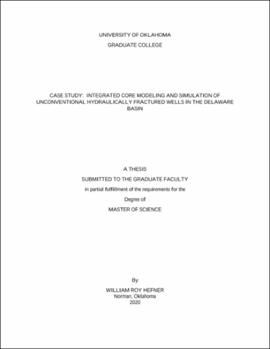| dc.description.abstract | The Early Paleozoic Wolfcamp formation is one of the main unconventional reservoirs in the Delaware Basin, and highly targeted by U.S. companies. Innovative completion techniques and representative core analysis have become more prevalent, while undeveloped location numbers are decreasing. Despite the increase in information gathering, integration of data for the lifecycle of the well is challenging prior to development. The scope of this study is to integrate geological, compositional fluid, and hydraulic fracturing data obtained from the field into a reliable 3D model to evaluate reservoir and production performance of the lifecycle a multi-stage hydraulically fractured well in the Wolfcamp A-XY formation of the Delaware Basin.
This case study illustrates the necessity of reservoir model implementation into the development process. A 3D geological and geomechanical reservoir model was constructed based on core and well log data obtained from a vertical pilot location in Eddy County, NM. The geomechanical model output was implemented into a hydraulic fracture simulator, consisting of 22 stages for an over 4000-foot horizontal development well, to evaluate and produce key fracture geometries and properties used in the simulation model. A compositional fluid simulator was then used to build an 11-component compositional fluid model representative of produced samples from the initial production of a development well. Then, two EOR miscible gas injection strategies, hydrocarbon gas and CO2, were used within the compositional model to examine the effect of injection rate, time to injection, and type of gas injected on the recovery of hydrocarbons. The results of the reservoir modeling show uncertainty greatly reduced when employing core data prior to simulation. Simulation results indicate that both hydrocarbon gas and CO2 miscible injection strategies yields incremental recoveries of 2 to 9.5%. Additionally, resulting analysis of sensitivities on production performance reveals that injection rate and time to injection are dependent on the type of gas injected. Results for each simulation illustrate the potential for enhanced recovery during the life of the well. | en_US |
